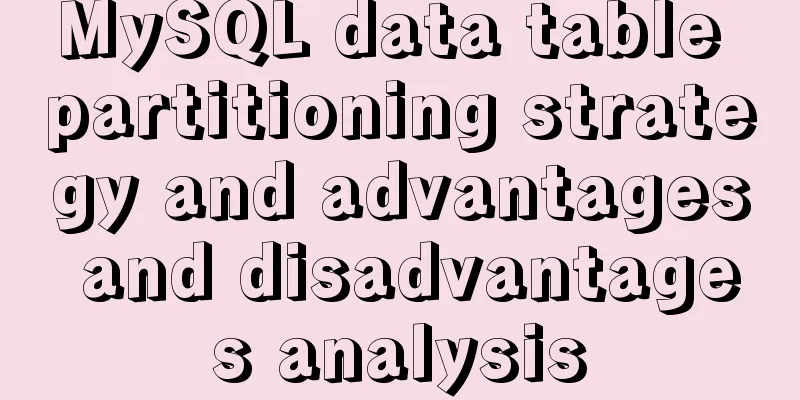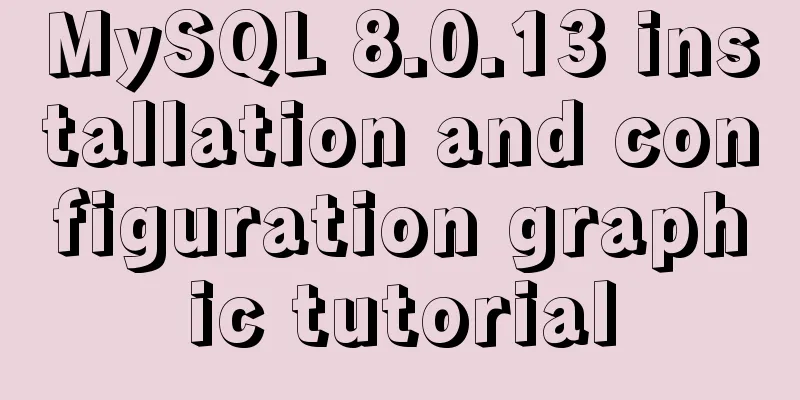MySQL data table partitioning strategy and advantages and disadvantages analysis

Why do we need partitions?When faced with huge data tables, at least one thing is certain: the table is so large that we cannot do a full table scan every time we query it. At this time, the index cannot be used, or the index is of little significance, not to mention that the maintenance cost and space occupied by the index are very high. If you rely on indexes, it will result in a large amount of fragmented and low-density data, which will cause thousands of random I/O accesses during queries and cause downtime. In this case, generally only 1-2 indexes will be used, and no more. In this case, there are two possible options: the query must search sequentially from the specified portion of the table or the desired portion of data and its index must match the server's memory. It bears repeating: when storage space is too large, binary tree indexes will not work unless the index covers the entire query. The server needs to find an entire row of data in the data table and perform random I/O operations in a large space span, which will result in unacceptable query response time. Maintaining indexes (disk space, I/O operations) is also expensive. This is a problem that partitioning can solve. The key here is that partitioning is a primitive form of indexing that is low overhead and allows us to retrieve results from nearby data. In this case, we can scan adjacent data sequentially or load adjacent data into memory for retrieval. The reason why the partition has low load is that it does not have a pointer to the corresponding data row and does not need to be updated. Partitioning does not precisely divide data into rows, nor does it involve so-called data structures. In fact, partitioning is equivalent to classifying data. Partitioning strategyFor large data tables, there are two strategies for partitioning:
Partition HazardsThe two partitioning strategies are based on two key assumptions: the search scope can be narrowed by filtering partitions during querying, and the cost of the partitions themselves is not high. However, these two assumptions may not always be valid. Here are some problems you may encounter:
As mentioned above, partitioning is not a perfect solution. The current version of MySQL has some other constraints:
Of course, with the update and iteration of MySQL versions, the support for partitioning is getting better and better, and many partitioning problems have been fixed. The above is the detailed content of MySQL data table partitioning strategy and advantages and disadvantages analysis. For more information about MySQL data table partitioning strategy and advantages and disadvantages, please pay attention to other related articles on 123WORDPRESS.COM! You may also be interested in:
|
<<: Solve the problem of blank gap at the bottom of Img picture
>>: Detailed process analysis of docker deployment of snail cinema system
Recommend
Nginx prohibits direct access via IP and redirects to a custom 500 page
Directly to the configuration file server { liste...
Embed player in web page embed element autostart false invalid
Recently, I encountered the need to embed a player...
How to install and deploy zabbix 5.0 for nginx
Table of contents Experimental environment Instal...
Vue+Openlayer realizes the dragging and rotation deformation effect of graphics
Table of contents Preface Related Materials Achie...
MySQL database implements MMM high availability cluster architecture
concept MMM (Master-Master replication manager fo...
React's context and props explained
Table of contents 1. context 1. Usage scenarios 2...
Echart Bar double column chart style most complete detailed explanation
Table of contents Preface Installation and Config...
Detailed tutorial on installing mysql-8.0.20 under Linux
** Install mysql-8.0.20 under Linux ** Environmen...
Linux Centos8 Create CA Certificate Tutorial
Install Required Files Yum install openssl-* -y C...
How to modify the initial password of a user in mysql5.7
When users install MySQL database for the first t...
CSS Problems with Using Position:fixed and Margin-top Together on Same-Level Elements
Problem Description I want to use CSS to achieve ...
JavaScript to achieve mouse tailing effect
Mouse effects require the use of setTimeout to ge...
MYSQL METADATA LOCK (MDL LOCK) MDL lock problem analysis
1. Introduction MDL lock in MYSQL has always been...
Summary of JS tips for creating or filling arrays of arbitrary length
Table of contents Preface Direct filling method f...
Summary of problems that may occur when using JDBC to connect to Mysql database
First, clarify a few concepts: JDBC: Java databas...









